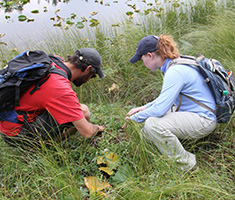Loon Research in Wyoming
Lead Investigators: David Evers and Lucas Savoy
Contributing BRI Staff: Chris Persico, Kate Taylor, and Jeff Fair
Common Loon Status Report 2021: Wyoming
Wyoming’s landscape is a study in contrasts, from shortgrass prairies and sagebrush steppes to the stunning peaks of the Rocky Mountains. Yellowstone National Park is dedicated to preserving the state’s natural environments and native species. One such species, the Common Loon, is in danger of disappearing. Since the mid-2000s, this population has declined by nearly 42 percent and is considered one of the most southern populations in its range. The Common Loon is considered the highest ranked Species of Greatest Need by the Wyoming Game and Fish Department. Download Status Report
Project Overview

In Wyoming, the Common Loon is the rarest breeding bird; they are listed as a Species of Greatest Conservation Need, as determined by the Wyoming Game and Fish Department. In 2012, Biodiversity Research Institute (BRI), in partnership with Yellowstone National Park (YNP), initiated a study to monitor and understand the local breeding loon population. In 2013, BRI created a dedicated working group in collaboration with governmental agencies including Yellowstone and Grand Teton National Parks, the Wyoming Game and Fish Department, and Bridger-Teton and Caribou-Targhee National Forests. The goals of BRI within the Wyoming Loon Working Group are to ensure that Wyoming’s small and isolated breeding population of Common Loons is self-sustaining. A wider understanding of loon ecology and threats will be important to assist governmental agencies with management and outreach efforts.
Have You Seen a Banded Loon?
BRI researchers have marked Common Loons across western North America with colored leg bands. Color-marking and resighting of loons allows us to monitor breeding individuals, calculate annual return rates to territories, track local movements and migratory routes, and determine overwintering areas.
You can help us track loons. If you see a loon, you can let us know. Download the information here.
Conservation Concerns

Loons are long-lived; they have relatively low annual productivity and a poor ability to colonize new breeding areas. Given its small size and disjunct location, the breeding loon population in Wyoming is at particularly high risk of local extinction and is highly susceptible to coastal threats (for first summering and wintering individuals). During the breeding season, general threats to this population include: (1) direct human disturbance to nests and chicks and take of adults; (2) water level fluctuations (especially related to climate change); (3) changes in prey abundance and composition; and, (4) contaminants (e.g., lead and mercury) and toxins (e.g., cyanobacteria). On the wintering grounds, Wyoming’s loon population is susceptible to hazards such as marine oil spills and commercial fishing nets.
Collaborators

Project Funding
The National Park Service provided initial funding for this project in 2012 and 2013. Additional funding came from the Wyoming Governor’s Big Game License Coalition in 2013. The Ricketts Conservation Foundation generously provided funding from 2013-2018.
Photo Credits: Header photo © BRI-Jonathan Fiely; Common Loons © Daniel Poleschook



